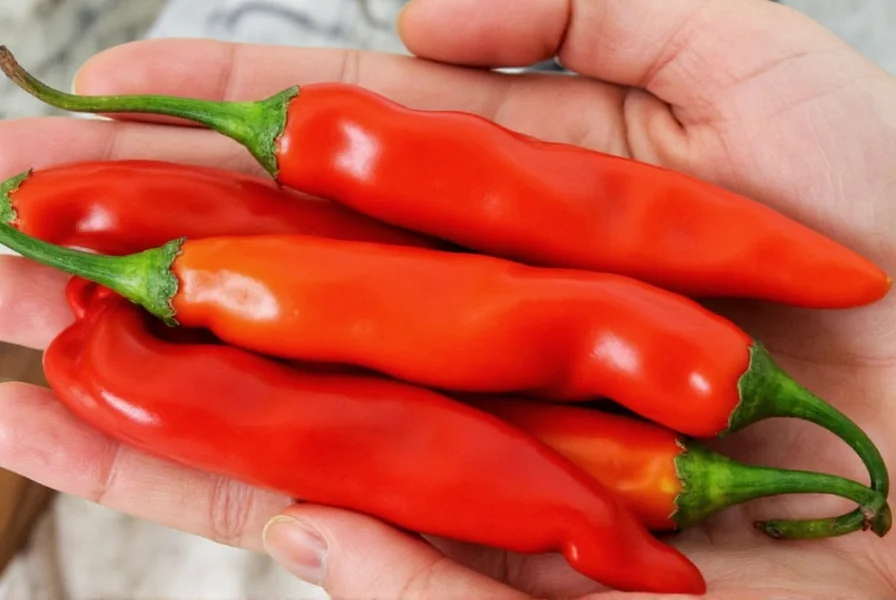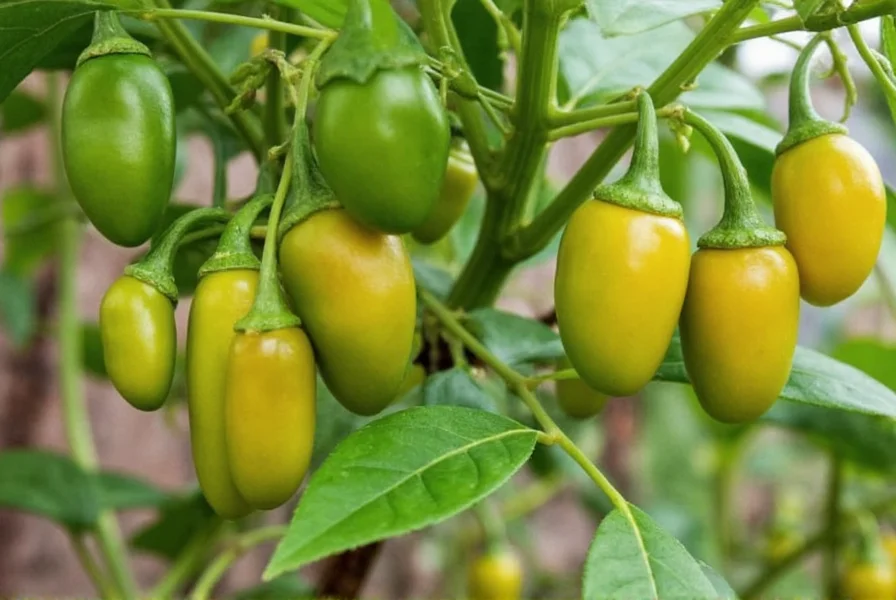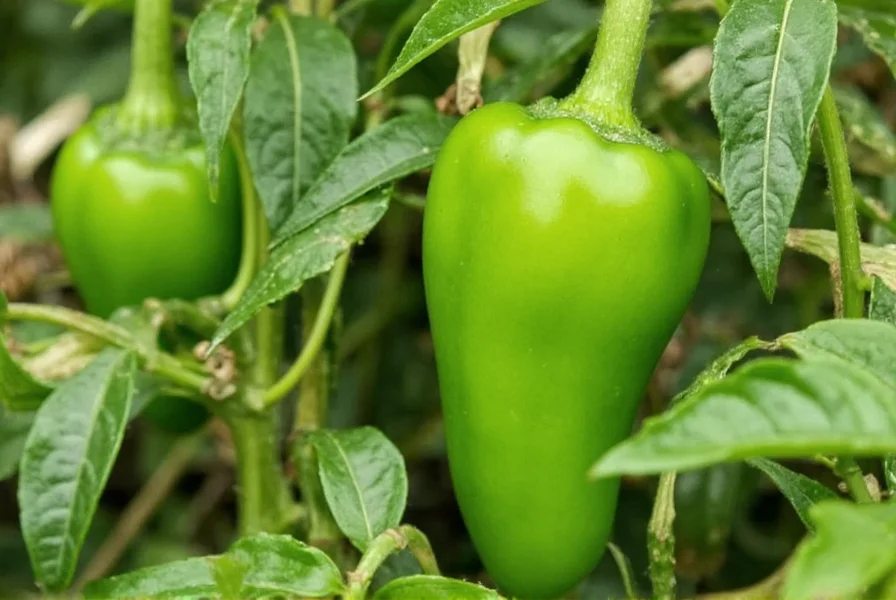A serrano chile pepper (Capsicum annuum) belongs to the same species as bell peppers and jalapeños but delivers a more intense heat experience. Native to Mexico's high-altitude regions, the name "serrano" translates to "from the mountains" in Spanish, reflecting its preferred growing conditions. Unlike many chile varieties that originated in Central or South America, serranos are distinctly Mexican in heritage, having been cultivated for centuries in traditional agricultural systems.
Physical Characteristics and Varieties
Serrano peppers typically measure 1-4 inches in length with a diameter of about 0.5-0.8 inches. They grow upright on the plant rather than hanging down, which is characteristic of many other chili varieties. The smooth, glossy skin transitions through several color stages:
| Color Stage | Flavor Profile | Common Uses |
|---|---|---|
| Green | Grassy, vegetal, bright | Salsas verdes, fresh preparations |
| Red | Richer, slightly sweeter, more complex | Cooked sauces, dried peppers |
| Orange/Yellow | Fruity, floral notes | Specialty salsas, decorative dishes |
While green serranos are most commonly found in North American markets, the riper red, orange, and yellow varieties offer increasingly complex flavor profiles with marginally higher heat levels. The internal structure features thick walls surrounding a central placenta loaded with capsaicin-producing glands—the source of the pepper's heat.
Heat Level and Flavor Profile
Understanding what is a serrano chile pepper requires examining its position on the Scoville scale. At 10,000-23,000 SHU, serranos sit firmly in the medium-heat category:
- 2-4 times hotter than jalapeños (2,500-8,000 SHU)
- Significantly milder than habaneros (100,000-350,000 SHU)
- Comparable to Thai bird chilies but with different flavor characteristics
The heat of serrano peppers builds more quickly than jalapeños but doesn't linger as long as habaneros. Their flavor profile combines bright acidity with grassy notes and subtle fruitiness, especially in the riper color varieties. Unlike some chilies that deliver one-dimensional heat, serranos offer a complex flavor experience that makes them valuable beyond just their spiciness—a key factor when considering serrano pepper uses in cooking.
Serrano vs Jalapeño: Key Differences
Many home cooks wonder about the difference between these two popular Mexican peppers. While they belong to the same species, several distinguishing factors exist:
- Size and shape: Serranos are smaller (1-4" long) and more slender with a tapered tip, while jalapeños are larger (2-4" long) and more bulbous
- Heat level: Serranos average 2-4 times hotter than jalapeños
- Growth habit: Serranos grow upright on the plant; jalapeños typically hang downward
- Flavor complexity: Serranos offer brighter, more complex flavor notes
- Wall thickness: Serranos have thinner walls, making them less suitable for stuffing
When substituting between these peppers, remember that using a serrano in place of a jalapeño will significantly increase the dish's heat level. For those exploring how hot are serrano peppers compared to other common varieties, they sit between cayenne peppers and tabasco peppers on the heat scale.
Culinary Applications
Serrano peppers shine in traditional Mexican cuisine but have gained popularity worldwide for their versatile flavor profile. Key culinary uses include:
- Salsas: The primary ingredient in many fresh salsas, particularly salsa verde when used green
- Guacamole: Adds heat without overwhelming the delicate avocado flavor
- Pickled preparations: Often pickled with onions and carrots as a condiment
- Infused liquids: Used to flavor vinegars, oils, and spirits
- Ceviche: Provides bright heat that complements seafood
When working with serranos, remember that the seeds and white ribs contain the highest concentration of capsaicin. For controlled heat levels, remove these elements before chopping. Chefs often recommend wearing gloves when handling multiple serranos, as the oils can transfer to sensitive areas like eyes. Understanding proper handling is essential for anyone exploring serrano pepper uses in cooking.

Growing Serrano Chile Peppers
For gardeners interested in cultivating their own supply, serranos thrive in warm climates with well-draining soil. Key growing considerations:
- Climate: Require 70-90°F temperatures; frost-sensitive
- Soil: Prefer slightly acidic, nutrient-rich soil with good drainage
- Sun exposure: Need 6-8 hours of direct sunlight daily
- Watering: Consistent moisture without waterlogging
- Maturity: Reach harvest stage in 70-80 days from transplanting
Unlike some chile varieties that require specific pollinators, serranos are self-pollinating and grow well in containers, making them suitable for patio gardening. The plants typically reach 24-36 inches in height with multiple branches producing dozens of peppers. When harvesting growing serrano chile peppers, pick them when firm and glossy, whether green or fully colored.
Nutritional Profile and Health Benefits
Beyond their culinary value, serrano peppers offer notable nutritional benefits. A single raw serrano (14g) contains:
- Nearly 100% of the daily recommended vitamin C
- Significant vitamin A and B6
- Potassium, magnesium, and iron
- Only 4 calories per pepper
The capsaicin that gives serranos their heat has been studied for potential health benefits including pain relief, metabolism boosting, and anti-inflammatory properties. Regular consumption of chile peppers like serranos has been associated with lower mortality rates in population studies. For those researching serrano pepper nutritional benefits, these peppers represent a nutrient-dense addition to a balanced diet.
Storage and Handling Tips
Proper storage extends the shelf life of serrano peppers significantly:
- Refrigeration: Store unwashed in a paper bag in the crisper drawer for 2-3 weeks
- Freezing: Freeze whole peppers for up to 6 months (no need to thaw before use)
- Drying: String and air-dry or use a food dehydrator for long-term storage
- Pickling: Preserves flavor while adding tangy complexity
When handling serranos, always wash hands thoroughly afterward and avoid touching your face. The capsaicin oils can remain on skin and surfaces for hours. If you experience burning sensations, dairy products like milk or yogurt can help neutralize the capsaicin better than water. These safety considerations are important for anyone learning about what is a serrano chile pepper and how to work with them safely.

Frequently Asked Questions
How does the heat of a serrano compare to other common peppers?
Serrano peppers measure 10,000-23,000 Scoville Heat Units, making them 2-4 times hotter than jalapeños (2,500-8,000 SHU) but significantly milder than habaneros (100,000-350,000 SHU). They're comparable to Thai bird chilies in heat but offer a brighter, more complex flavor profile.
Can I substitute serrano peppers for jalapeños in recipes?
Yes, but with caution. Since serranos are 2-4 times hotter than jalapeños, use approximately half the amount of serranos when substituting. For milder heat, remove the seeds and white ribs before chopping. The flavor profile differs slightly, with serranos offering brighter, more complex notes.
What's the best way to reduce the heat of serrano peppers?
To reduce heat, remove the seeds and white ribs (placenta) where most capsaicin concentrates. Soaking chopped peppers in salt water for 10-15 minutes can also draw out some heat. Cooking methods matter too—roasting can mellow the heat while pickling often preserves it. Remember that heat perception varies by individual.
Where can I find serrano peppers if they're not in my local grocery store?
Serrano peppers are commonly available at Mexican grocery stores, farmers markets, and increasingly in mainstream supermarkets, especially in the southwestern United States. If unavailable fresh, look for them pickled in jars or consider growing your own from seeds, which are widely available online. During off-seasons, frozen serranos maintain good flavor for cooked applications.
Are there different varieties of serrano peppers?
Yes, several serrano varieties exist including 'Hidalgo' (bright red, medium heat), 'Tampiqueño 74' (yellow-orange, slightly milder), and 'Colima' (dark green to red, hotter than average). The most common commercial variety is simply called 'Serrano' and produces the familiar green-to-red color progression. Specialty seed catalogs often carry multiple varieties for home gardeners.











 浙公网安备
33010002000092号
浙公网安备
33010002000092号 浙B2-20120091-4
浙B2-20120091-4